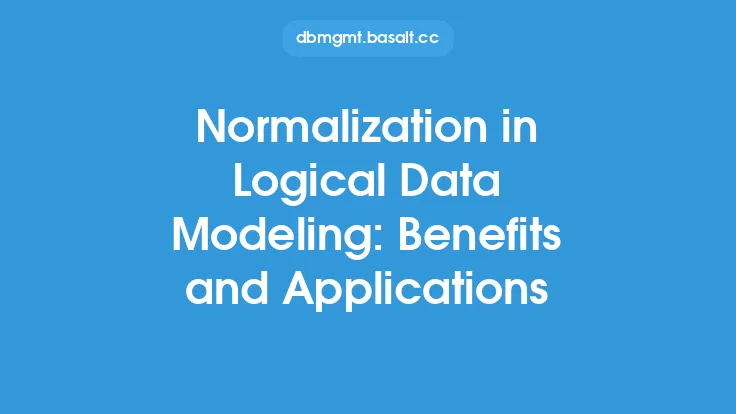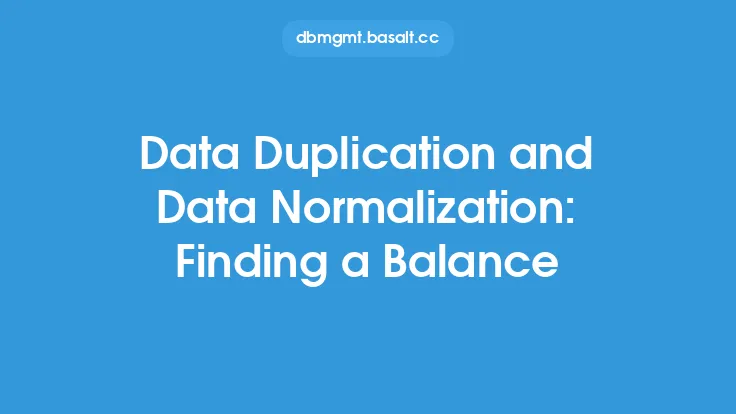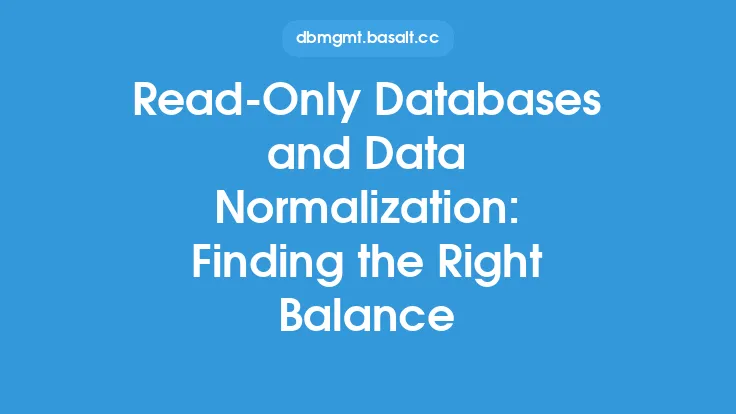When designing a database, two fundamental concepts often come into play: data redundancy and data normalization. While they may seem like opposing forces, they both serve crucial purposes in ensuring the integrity, scalability, and performance of a database. In this article, we'll delve into the world of data redundancy and data normalization, exploring their definitions, benefits, and drawbacks, as well as the scenarios in which one approach might be preferred over the other.
Introduction to Data Normalization
Data normalization is the process of organizing data in a database to minimize data redundancy and dependency. It involves dividing large tables into smaller, more manageable ones, and linking them through relationships. Normalization helps to eliminate data anomalies, such as insertion, update, and deletion anomalies, which can occur when data is redundant or inconsistent. By normalizing data, database designers can ensure that each piece of data is stored in one place and one place only, reducing the risk of data inconsistencies and making it easier to maintain data integrity.
Understanding Data Redundancy
Data redundancy, on the other hand, refers to the duplication of data within a database. This can occur when the same data is stored in multiple tables or locations, often to improve performance or reduce the complexity of queries. While data redundancy can provide benefits, such as faster query execution and improved data availability, it can also lead to data inconsistencies and make it more challenging to maintain data integrity. Data redundancy can be categorized into two types: controlled redundancy and uncontrolled redundancy. Controlled redundancy is intentional and managed, whereas uncontrolled redundancy is unintentional and can lead to data inconsistencies.
Data Redundancy vs Data Normalization: A Comparison
When deciding between data redundancy and data normalization, it's essential to consider the trade-offs between the two approaches. Data normalization provides several benefits, including improved data integrity, reduced data redundancy, and better scalability. However, it can also lead to more complex queries and slower performance. Data redundancy, on the other hand, can improve performance and reduce the complexity of queries, but it can also lead to data inconsistencies and make it more challenging to maintain data integrity. Ultimately, the choice between data redundancy and data normalization depends on the specific requirements of the database and the needs of the application.
Scenarios Where Data Redundancy is Preferred
There are several scenarios where data redundancy might be preferred over data normalization. For example, in a database that requires high performance and fast query execution, data redundancy can be used to improve performance by reducing the number of joins required to retrieve data. Additionally, in a database that requires high availability and data redundancy can be used to ensure that data is available even in the event of a failure. Data redundancy can also be used in data warehousing and business intelligence applications, where data is often denormalized to improve query performance.
Scenarios Where Data Normalization is Preferred
On the other hand, there are several scenarios where data normalization is preferred over data redundancy. For example, in a database that requires high data integrity and consistency, data normalization can be used to ensure that data is accurate and consistent across the database. Additionally, in a database that requires high scalability and flexibility, data normalization can be used to improve scalability and reduce the complexity of queries. Data normalization is also preferred in databases that require strong data relationships and constraints, such as relational databases.
Best Practices for Implementing Data Redundancy and Data Normalization
When implementing data redundancy and data normalization, there are several best practices to keep in mind. First, it's essential to understand the requirements of the database and the needs of the application. This will help determine whether data redundancy or data normalization is the best approach. Second, it's crucial to consider the trade-offs between data redundancy and data normalization, including the impact on performance, scalability, and data integrity. Finally, it's essential to implement data redundancy and data normalization in a way that is consistent and manageable, using techniques such as controlled redundancy and data normalization rules.
Conclusion
In conclusion, data redundancy and data normalization are two fundamental concepts in database design that serve crucial purposes in ensuring the integrity, scalability, and performance of a database. While they may seem like opposing forces, they both have their benefits and drawbacks, and the choice between them depends on the specific requirements of the database and the needs of the application. By understanding the definitions, benefits, and drawbacks of data redundancy and data normalization, database designers can make informed decisions about how to design and implement their databases, ensuring that they are scalable, flexible, and performant. Ultimately, the key to successful database design is finding a balance between data redundancy and data normalization, and using the right approach for the specific needs of the application.





